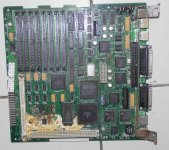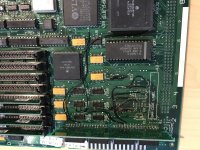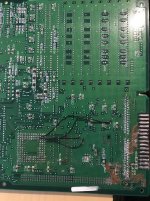Bolle
Well-known member
I thought I should share this as a motivation for others 
Got this spare board off eBay for 5€ mainly for sourcing parts.
It started like that:

I went ahead and got all the gunk off and removed everything that got in the way while cleaning:

The CPU was toast, RTC and its two diodes were more or less gone, SIMM socket had corroded to the point of no return as well.
I started buzzing out a few connections just for fun and ended up doing the whole address and data busses. Identified roughly 20 broken traces.
A rainy day and half a roll of rework wire later:



It is far from pretty but boy I couldn't believe it actually chimed right on the first try.
Got to clean up a little now and see if I can get it to boot from SCSI. The SCSI chip seems to have gotten a nice load of cap goo and is probably gone. It tries to boot from HDD the way it is now but aborts and just flashes the LED on the HDD every few seconds.
I should have a replacement chip somewhere in the spare parts box.
To be continued...
Got this spare board off eBay for 5€ mainly for sourcing parts.
It started like that:

I went ahead and got all the gunk off and removed everything that got in the way while cleaning:

The CPU was toast, RTC and its two diodes were more or less gone, SIMM socket had corroded to the point of no return as well.
I started buzzing out a few connections just for fun and ended up doing the whole address and data busses. Identified roughly 20 broken traces.
A rainy day and half a roll of rework wire later:



It is far from pretty but boy I couldn't believe it actually chimed right on the first try.
Got to clean up a little now and see if I can get it to boot from SCSI. The SCSI chip seems to have gotten a nice load of cap goo and is probably gone. It tries to boot from HDD the way it is now but aborts and just flashes the LED on the HDD every few seconds.
I should have a replacement chip somewhere in the spare parts box.
To be continued...
